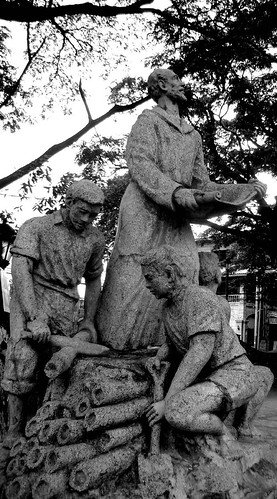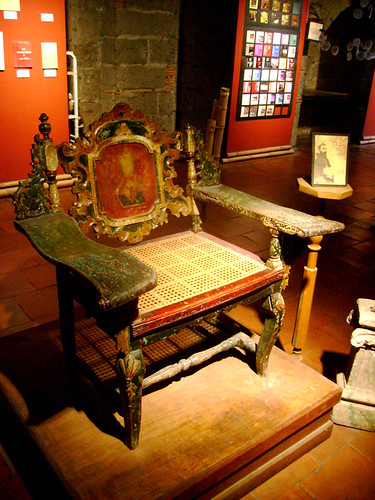 [/caption]
[/caption]I was looking at my old collection of photographs when I saw pictures of St. Josephs's of Las Pinas that I took s sometime in 2006 when I was looking for the old bridge that was built by the master builder of Las Pinas, the great Padre Diego Cera, creator of the iconic bamboo organ and founder of the town parish. Today, the recollet Padre is regarded as the founder of the old Las Pinas town [although records show that it was founded in 1762, Cera came inthe early 1800's], but still such an honor should be given to Cera, as the emblem of the ciudad would show today his legacy, the Bamboo Organ.
In front of the parish is a grey stone monument of Padre Cera, surrounded by his workers, digging the bamboos out of the salty sands of the bay. It took him almost a decade to complete his project. This technique made the otherwise fragile bamboo into a hardy material, replacing the traditional metal pipes used in popular european pipe organs - necessity they say is the mother of all invention.
Whats astounding is that the Recollet father built the church and the organ almost at the same time, testament to his uncanny planning skills. Today, inside the mini museum, one could find some of the original pieces of the organ which was taken to Europe for a full repair sometime in the 70's.
The annual star attraction of the town is the international event, the Bamboo Organ festival, where both local and internation choir groups compete in the spirit of celebrating the uniqueness of this beautiful musical instrument.
A representative of St. Joseph, Msgr. Albert Venus, expressed his disappointment to see that foreigners are more interested than locals, in his words "its alarming". We're a generation without a clear understanding of our heritage and identity, so this attitude is not really surprising Padre.
---
Most people think that Las Pinas got its name from the tropical fruit Pina, a visit to the old Iglesia of San Jose would disprove this, the original bell now sits in front of the door that leads to the loft, inscribed on the bell is the word "Las Penas" [Siendo Cura-del Pueblo de las Peñas el M.R.P. Padre Diego Cera se Fundio este equilon ano de 1820] which literally means hardship [sacrifice], its interesting how it became "Pinas" for there was no record of any pineapple industry in this once fishing district of Paranaque.
[caption id="" align="alignnone" width="323" caption="The Parochial Chair"]
 [/caption]
[/caption]Inside the museum of the Las Piñas Parochial Church are other relics. Pictures and memorabilias from Padre Ezequiel Moreno, a Spanish Recollet so admired by his town mates that when he was transferred to Sto Tomas, the Las Pineros protested the decision in front of the Recollets headquarters in Intramuros, said to be the first ever people power in our history, he went on to fulfill his duties in Sto Tomas and other provinces under the Recollets, he became a Bishop in Latin America. He is also regarded as one of the founders of Puerto Princesa - Nick Joaquin in one of his essay, said that among the paladins of clothe, the recollets were the specialist in "jungle missions", today, they are credited for converting Negros into the successful sugar maker that it is.
They were also once the richest order in the country, with big shares in San Miguel and land holdings greater than the other orders.



No comments:
Post a Comment